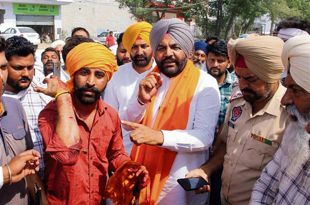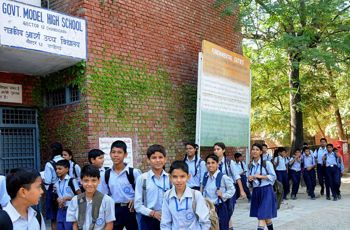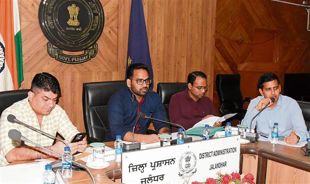
FLAGSHIP SCHEME: MGNREGA provides 100 days of employment to workers in rural areas to build assets linked to agriculture.
Sushma Ramachandran
Senior Journalist
EVEN as the Finance Minister unveils a series of measures to battle the economic slowdown, it is clear that one sector is being left out of the largesse. And that is the rural economy. It is here that the largest amount of pain is being felt due to slower growth. In Maharashtra, where the new political scenario is taking weeks to firm up, governance has been the loser, especially the agricultural sector, which needs support after disastrous floods in the kharif season. In state after state, farmers are in dire straits, not
to mention the landless labour force. It is in these segments of the economy that the government needs to provide succour. Such support, in turn, will push up demand in the rural economy and boost consumption at the bottom of the pyramid, where it will have the biggest impact.
One of the biggest ways in which support can be given is by stepping up the allocation for the Mahatma Gandhi National Rural Employment Guarantee Act (MGNREGA) programme. The outlay for the current fiscal has been frozen at Rs 60,000 crore, the same level as in the previous year. This needs to be doubled to meet the needs of those who are increasingly looking for basic employment in the current economic downturn. As it is, the latest data shows that over 80 per cent of the outlay has already been utilised, clearly indicating the rising demand for employment in rural areas. The Rural Development Ministry is reported to have sought an additional Rs 20,000 crore in supplementary demands to continue the programme for the rest of the year.
The significance of MGNREGA is that it provides 100 days of employment to workers in the rural areas to build productive assets linked to agriculture. In drought-hit areas, this has been increased by 50 days. But what is worrying is that the average wage under the programme has been declining, compared to market wages over the years. The MGNREGA wages have been linked in the past to the consumer price index for farm labour, which has not been revised for several decades. The index is now proposed to be updated in a bid to increase the wages under the scheme. However, the government needs to make a take larger leap in terms of wages if it is
to provide the desired stimulus to the rural economy.
It must be recalled that MGNREGA was severely criticised by the Bharatiya Janata Party before it came to power in 2014. It was viewed as a scheme that focussed on poverty but was not considered a solution to poverty. Subsequently, however, the NDA adopted the scheme and even expanded it. In fact, the allocations under the programme virtually doubled in the first tenure of the Modi government, from roughly Rs 33,000 crore to Rs 60,000 crore
currently. The increased outlay went along with efforts to ensure that the scheme was made more efficient by creating productive assets in agriculture and allied sectors. The next step was to provide skilling to those working under the programme, but this is likely to take some time.
But the scheme was always considered the flagship of the UPA government. Ironically, now with increasing numbers turning to this anti-poverty scheme, the NDA government clearly has no option but to expand it sufficiently to meet the needs of the jobless due to the slowdown. The expansion has to be not only in terms of increasing numbers but also in ensuring that reasonable wages are paid to the workers. In some states, apparently, wages under the scheme have fallen below the stipulated minimum wages. The government must not have a
half-hearted approach to the programme and needs to increase wages to realistic levels. Besides, it will put more money in the hands of the weakest segments of society and, ultimately, provide the much-needed push to consumption.
Apart from this scheme, which many view as merely palliative, there is a need to bring about larger structural reforms in the agriculture sector. A much bigger focus needs to be put on the rural economy right now when farmers are facing distress due to stagnant farm prices and crop failures either due to drought or floods. There was a time when India worried about whether it would be able to produce enough to feed its large population. That problem has been resolved with overflowing granaries in recent years. The farmer is now finding it difficult to get remunerative returns on his investment. Hence, the protests with farmers throwing milk and vegetables in the streets, symbolises the stress faced due to lack of buyers.
It is high time the farm sector is made a priority in this country. It provides employment to about half the country’s workforce, but its share in the total GDP has shrunk to only about 15 per cent. The state of Indian agriculture is well exemplified by the state of Punjab. Held up as a success for being the granary of the nation along with Haryana, it has provided the maximum wheat and rice stocks to the Central inventories. But the state has high unemployment, rampant drug addiction and sizable numbers of youth looking to migrate abroad for better opportunities. It’s a unique paradox, which the state is now struggling to overcome. Other states also have serious problems in the agriculture sector, though they may be different, like being drought or flood-prone.
But the undeniable fact is that marketing systems remain archaic and agro-processing has not been made a priority. The need to ensure that farm debt is restructured has not been given enough attention while loan waivers are dismissed as populism. Similarly, farmer suicides are downplayed and, worse, these are linked to relatively small loans. For corporates, enormous amounts are merely converted into NPAs without thinking twice.
The bottomline is that the rural economy is in distress and the government needs to become its saviour. In doing so, it could also kickstart a cycle of faster growth and pull the economy out of its current slough.



























